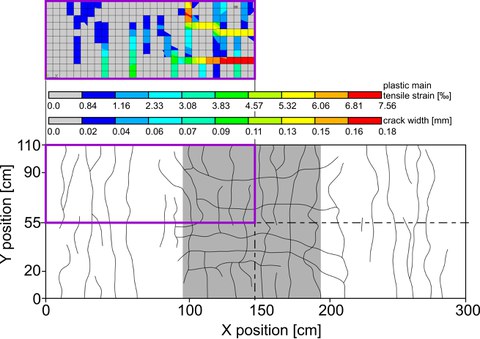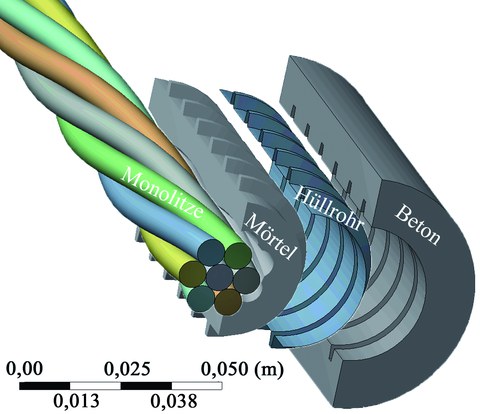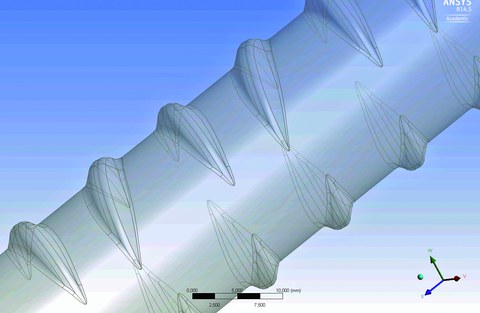Behaviour of concrete and posttensioning steel under transverse tension
Table of contents
Project data
| Titel | Title Modellierung des Verbundverhaltens von Beton- und Spannstahl unter Querzug | Behaviour of concrete and posttensioning steel under transverse tension Förderer | Funding Bundesministerium für Wirtschaft und Energie (BMWi) Zeitraum | Period 07/2012 − 09/2015 Leiter | Project manager Prof. Dr.-Ing. Dr.-Ing. E.h. Manfred Curbach Bearbeiter | Contributor Dipl.-Ing. Robert Zobel |
The presented project was funded by the German Federal Ministry of Economic Affairs and Energy (BMWi, project no. 1501428) on basis of a decision by the German Bundestag.
Report in the year book 2015
Slabs under tension

Comparison of the crack patterns in the simulation (top left) with test results (below)
The basic assumption for reinforced and prestressed concrete components to achieve their load bearing capacity lies at the interaction between reinforcing steel and concrete. In the area of cracks, the tensile forces are carried out by the reinforcement alone and are transmitted into the concrete via the bond among reinforcement and concrete. Crack width and distance are largely dependent on the reinforcement´s bond properties. As well as the stiffness, the bond properties also influence the load bearing and deformation behaviour.
Based on the numerical investigation done in the last two years, simulations of reinforced structures under biaxial tensile stresses marked the end of the project. Experiments of an already completed project were modelled. There, large-size reinforced concrete panels were tested, which contained regular reinforcing steel in longitudinal and lateral direction. Additionally, three post-tensioned tendons were included. Considering the symmetry of the specimen, the numerical model of a large-scale test was reduced to one quarter of the plate size. Solid elements for concrete and beam elements for reinforcing steel were used. With the help of an implemented specific node-to-node contact model, the bond behaviour was considered. The description and representation of nonlinear material behaviour and fundamental phenomena of the damage of concrete is facilitated by an elasto-plastic material model.
The simulation results match well with the experimental measurements. Biaxial tensile stresses have an influence on the load bearing behaviour of a structural element. The load-deformation behaviour of the simulations shows a good agreement with the experimental results. In the cracking phase, the orthogonal net of reinforcing steel and the post-tensioned tendons act at crack edges. The cracking phase was mainly affected by transverse tension-induced longitudinal cracks. Moreover, the longitudinal cracks led to a decrease of the flexural stiffness in the un-cracked stress states. On the other hand, a simultaneous load led to an increase.
In the future, the ANSYS implemented bond model can be used for modelling large structures. Thus, the predictability of both the behaviour of the overall structure and the development of cracks can be improved.
Report in the year book 2014
Inside View

Components of a detailed modelling of a single strand with subsequent bond
Mixed reinforced components are characterized by being versatile in practice, durable in service, and stable in extreme situations. In order to ensure this performance, investigations of the individual components steel and concrete, as well as studies of bond behaviour between the two materials, are of great importance. Besides the experimental tests, numerical studies on the bond behaviour using the finite element method (FEM) are absolutely essential to gain a better understanding of the complicated interaction processes. Using the FEM, it is possible to gain new insights about bond behaviour. Simultaneously, with a suitable numerical model, the number of experimental bond tests can be reduced.
While last year’s numerical studies were focused on the interaction between concrete and reinforcement steel, this year’s emphasis was on bond behaviour of post-tensioned concrete. Analogous to the bond behaviour between reinforcing steel and concrete, the known bond mechanism can be applied to post-tensioned concrete. Depending on the slip (relative displacement between the bonding parts), adhesion, friction and mechanical interaction are at work. Compared to reinforcing steel, the bond behaviour of post-tensioned concrete is more complex due to extra components, injection mortar and jacket tube. The bond behaviour is affected by these components. Compared to the reinforced concrete, the factors influencing the bond behaviour of post-tensioned concrete are more diverse.
Because of geometry and large number of contacts, one particular challenge was the detailed modelling of different surface profiles of tensioning steels. Among other things, single strands, tensioning steel strands, ribbed tensioning steel or smooth tension steel were numerical investigated by means of pull-out tests. The simulations results confirmed the experimental results. The internal crack initiation and the formation of compression struts depended particularly on the surface profiling of the tensioning steel and the thickness of the injection mortar. The bond stress-slip curves varied depending on the surface profiling of the tensioning steel.
Report in the year book 2013
Bond Between Concrete and Reinforcing Steel Under Transverse Tension

Modeled reinforcing steel.
Many factors influence the bond between concrete and reinforcing steel. One of the most important factors affecting the mode of bond failure is transverse tension, which occurs − for instance- in vessels under internal pressure or in two-way slabs.
This bond behaviour is often used to describe the relationship between bond stress − that is the sum of the three bond mechanisms adhesion, friction and mechanical interaction − and slip, which means the displacement between concrete and reinforcing steel. The bond stress-slip relationship and mode of bond failure will be experimentally determined through pull-out tests. Generally, two different modes will be distinguished: pull-out of the reinforcing steel bar from the concrete or sudden splitting of the concrete. Besides the mode of bond failure, transverse tension also influences the development of cracks, the crack widths and the crack pattern. As regards vessels and containments, it is of great importance to avoid leakage. Hence, a better and more accurate prediction of the behaviour of such structures requires the realistic analysis of the components steel and concrete as well as their bond behaviour.
Furthermore, with the usage of detailed modelling of rebar ribs a fine finite element mesh is generated. This leads to significant resource requirements. Therefore, the detailed modelling is generally neglected and the reinforcing steel is approximated as a smooth rebar. The bond properties between concrete and reinforcing steel will be carried out with contact elements, which act between the two bond partners. For the implementation of the experimental results in the FE program ANSYS, a flat contact element will be developed. The flat contact element depicts the bond properties under transverse tension. In order to gain a comparable calculation basis, pull-out tests are modeled and simulated. Subsequently, the results are compared with the experimental data. In addition to the validity, the functionality of the model is important. After the developed contact element has been successfully verified, it can also be used in large structures. Thus, the predictability of the behaviour of the overall structure and the development of cracks can be improved.
